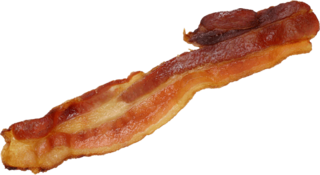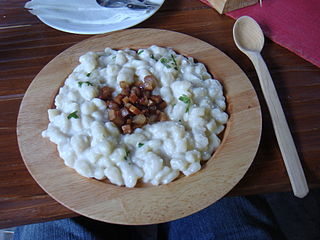
A deer or true deer is a hoofed ruminant ungulate of the family Cervidae. It is divided into subfamilies Cervinae and Capreolinae. Male deer of almost all species, as well as female reindeer, grow and shed new antlers each year. These antlers are bony extensions of the skull and are often used for combat between males.

Bacon is a type of salt-cured pork made from various cuts, typically the belly or less fatty parts of the back. It is eaten as a side dish, used as a central ingredient, or as a flavouring or accent. Regular bacon consumption is associated with increased mortality and other health concerns.

Goulash is a soup or stew of meat and vegetables seasoned with paprika and other spices. Originating in Hungary, goulash is a common meal predominantly eaten in Central Europe but also in other parts of Europe. It is one of the national dishes of Hungary and a symbol of the country.

Chronic wasting disease (CWD), sometimes called zombie deer disease, is a transmissible spongiform encephalopathy (TSE) affecting deer. TSEs are a family of diseases thought to be caused by misfolded proteins called prions and include similar diseases such as BSE in cattle, Creutzfeldt–Jakob disease (CJD) in humans and scrapie in sheep. Natural infection causing CWD affects members of the deer family. In the United States, CWD affects mule deer, white-tailed deer, red deer, sika deer, elk, caribou, and moose. The transmission of CWD to other species such as squirrel monkeys and humanized mice has been observed in experimental settings.

Arby's is an American fast food sandwich restaurant chain with more than 3,300 restaurants. The flagship property of Inspire Brands, it ranked third in systemwide sales in the United States in the quick-service and fast-casual restaurant industries in 2012, behind Subway and Panera Bread. In October 2017, Food & Wine called Arby's "America's second largest sandwich chain ".

Austrian cuisine is a style of cuisine native to Austria and composed of influences from Central Europe and throughout the former Austro-Hungarian Empire. Austrian cuisine is most often associated with Viennese cuisine, but there are significant regional variations.

Game or quarry is any wild animal hunted for animal products, for recreation ("sporting"), or for trophies. The species of animals hunted as game varies in different parts of the world and by different local jurisdictions, though most are terrestrial mammals and birds. Fish caught non-commercially are also referred to as game fish.

Salisbury steak is a dish originating in the United States and made from a blend of ground beef and other ingredients, being considered a version of Hamburg steak. Today, Salisbury steak is usually served with a gravy similar in texture to brown sauce, along with various side dishes, such as mashed potatoes and cooked vegetables. It is a common menu item served by diners and is frequently available as a TV dinner in supermarket frozen food sections.

Slovak cuisine varies slightly from region to region across Slovakia. It was influenced by the traditional cuisine of its neighbours and it influenced them as well. The origins of traditional Slovak cuisine can be traced to times when the majority of the population lived self-sufficiently in villages, with very limited food imports and exports and with no modern means of food preservation or processing.
A deer farm is fenced piece of a land suitable for grazing that is populated with deer species, such as elk, moose, reindeer, or especially white-tailed deer, raised as livestock.

Ribs of pork, beef, lamb, and venison are a cut of meat. The term ribs usually refers to the less meaty part of the chops, often cooked as a slab. Ribs of bison, goat, ostrich, crocodile, alligator, llama, alpaca, beefalo, African buffalo, water buffalo, kangaroo, deer, and other animals are also consumed in various parts of the world.

Marbled meat is meat, especially red meat, that contains various amounts of intramuscular fat, giving it an appearance similar to marble.

Deer hunting is hunting deer for meat and sport, an activity which dates back tens of thousands of years. Venison, the name for deer meat, is a nutritious and natural food source of animal protein that can be obtained through deer hunting. There are many different types of deer around the world that are hunted for their meat. For sport, often hunters try to kill deer with the largest and most antlers to score them using inches. There are two different categories of antlers. They are typical and nontypical. They measure tine length, beam length, and beam mass by each tine. They will add all these measurements up to get a score. This score is the score without deductions. Deductions occur when the opposite tine is not the same length as it is opposite. That score is the deducted score.
Elk farming is an agricultural industry for the production of elk as livestock or for the sport of hunting. Elk have a variety of uses. The velvet antler or, the antler in the premature stages of growth, is believed by some to have medicinal purposes. Elk are also raised for venison, their meat. All of these markets are rising in popularity thus causing an increase in the breeding industry. Other species of similar type are farmed in the same way such as deer, moose, and red stag.

The cuisine of Ohio is part of the broader regional cuisine of the Midwestern United States.

Meat on the bone or bone-in meat is meat that is sold with some or all of the bones included in the cut or portion, i.e. meat that has not been filleted. The phrase "on the bone" can also be applied to specific types of meat, most commonly ham on the bone, and to fish. Meat or fish on the bone may be cooked and served with the bones still included or the bones may be removed at some stage in the preparation.

A steak is a thick cut of meat generally sliced across the muscle fibers, sometimes including a bone. It is normally grilled or fried. Steak can be diced, cooked in sauce, such as in steak and kidney pie, or minced and formed into patties, such as hamburgers.

Se'i or sei is an Indonesian smoked meat from Kupang, Timor island, East Nusa Tenggara, Indonesia. Se'i may be derived from a variety of meats, with pork, beef or game animals such as venison as common offerings. Today, the most popular se'i meat is pork.
Maui Nui Venison is a venison producer on the island of Maui, Hawaii. The company harvests axis deer, an invasive species in Hawaii, in order to balance the population, and sells the resulting meat. Its night harvesting and field processing system is unique in the world.



















